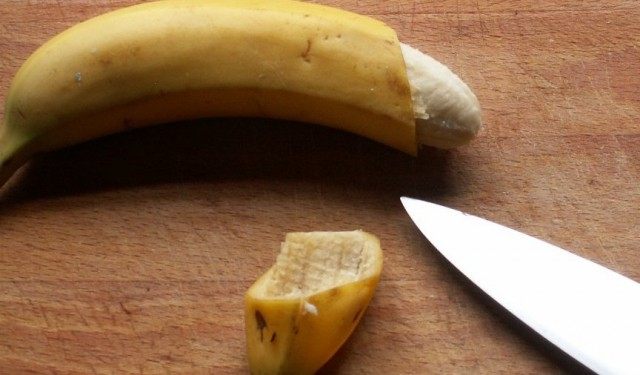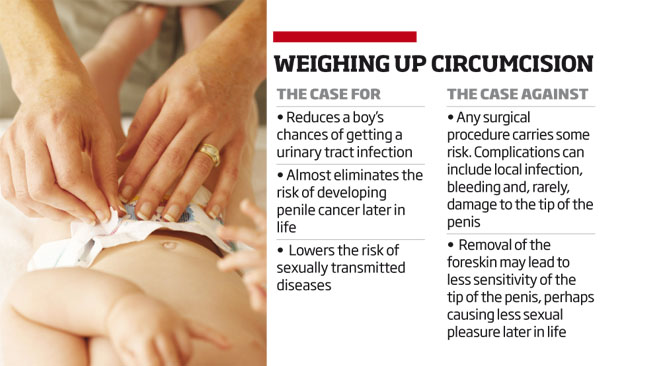Circumcision: Health Benefits and Risks
To circ or not to circ – that is the question for many parents. Let’s compare benefits and risks.
Circumcision: definition and major facts

Circumcision stands for a surgical removal of the penis’ foreskin covering male genitalia. Factually, circumcision is an ancient ritual that has religious origins, but it is also quite common today as well. Many parents decide to make circumcision to their newborn boys for religious reasons. Circumcision in adult men is usually a subject to certain healthy difficulties and is performed under local anesthesia. After circumcision it is not possible to restore the original penis’ form.
Interesting fact: Women can be circumcised as well. For example, there are multiple cases of circumcision for women in Jamaica. For example, take a look at the table showing the benefits and risks of circumcision in males and females made by the scientists from Kingston, Jamaica in 2008.
Circumcision – how to procedure is done?
There are 5 various types of how circumcision can be done:
- Minimal – the small part is deleted of the foreskin of the penis appearance with virtually no changes;
- Partial – the foreskin still covers the head of the penis, but the external opening of the urethra is opened.
- Common (full)– total exposure of the head of the phallus and the coronal sulcus is closed. This type of circumcision is most common;
- Moderate (or average) – the penis’ head open and the remaining part of the foreskin’s diameter doesn’t exceed the diameter of the crown of the head;
- Rigid – the complete removal of the foreskin. Because of this, when a penis is aroused a man can feel uncomfortable, especially when the skin on the penis is stretched. In extreme cases, excessive skin removal may cause penis’s retraction into the body’s cavity.
The common type of circumcision in infants is performed in a hospital, as a rule, within 10 days after a child’s birth.
The newborn is placed on a hard surface. The arms and legs of the child are fixed with special bands to hold a child motionless during the procedure. Then a doctor cleans a boy’s penis and injects a local anesthetic. Local anesthetics provide the nerve blockade to nerves of the penis. Then to the head of the penis is attached a plastic ring for trimming of foreskin. The foreskin is removed by means of a sterile scalpel or scissors and then this area is loosely wrapped with a sterile bandage. This procedure takes from 5-10 minutes.
The procedure is practically the same for the older boys and male adults, but they may need to take a general anesthetic and more stitches to prevent further bleeding and infections.
After a surgery the penis’ head can discharge yellowish mucus or have a crust. Minor bleeding is also normal in the early days after circumcision.
After the procedure, the penis must be washed regularly. Parents of newborns need to change the bandage each time when they change diapers and lubricate the head of the penis with petroleum jelly to keep it from sticking to a diaper. Diapers should not press too tightly or snugly. Once the penis is healed, wash it with soap and water during swimming.
Why to do circumcision to boys and men?
Male circumcision can be done by:
- Religious reasons. The rite of circumcision is a common practice for people who practice Judaism or Islam and it is also practiced in many African communities as tribal or ethnic tradition;
- Medical reasons (such as phimosis, more information here).

Currently, U.S. Academy of Pediatrics doesn’t recommend circumcision to newborn boys, because there are not enough evidences supporting the benefits of this surgery. They think that this rather painful procedure must be recommended only for males of an older age to cure phimosis or a severe penile infection.
Interesting fact: Many people erroneously believe that circumcision makes a penis cleaner. However, the opposite fact is true. Circumcised penis gets dirtier, since it doesn’t have the structure that “removes” the dirt – foreskin. Each penis, circumcised or not, you need to wash carefully under the running water while taking a bath or shower.
The health benefits of circumcision:
- Circumcision decreases the risk of UTIs (it is a proven fact that circumcised men have a decreased risk of urinary tract infections along with more severe infections occurring early in their life and leading to kidney diseases in future);
- To support cleaning of the glans of a penis (circumcision facilitates the cleaning of a male sexual member);
- It is a proved fact that circumcision can protect from penile cancer;
- Prevention of the very common disorder – phimosis (i.e. narrowing of the penis’ foreskin opening) and paraphimosis (the head’s infringement);
- Reduced risk of STDs (including HIV and AIDS, however, sex should be protected as well);
- Prevention of balanitis (inflammation of the penis’ head) and balanoposthitis (inflammation of the penis’ glans and foreskin).
Who can’t be circumcised?
- Circumcision is contraindicated for males with certain disorders involving the development of blood clotting pathologies and because of the anatomical structure of the penis;
- Also circumcision is not recommended for premature boys, requiring supportive medical care for a life.
NB: circumcision doesn’t affect healthy men’s reproductive function and doesn’t reduce the sexual pleasure of men or their partners.
The health risks of circumcision

Like any other medical surgery circumcision can be followed by multiple risks to a young boy’s health:
- Bleeding and infections in the area where the procedure was done;
- Penis can be accidentally irreversibly and that can lead to erectile dysfunction;
- Painful sensations that sometimes won’t go away for a life;
- Penis’ glans can be infected and there is possible inflammation;
- Enhanced risk of the inflammation in the penis’ meatus;
- A man can have a non-standard reaction to anesthesia done in this sensitive area.
What are the possible complications to adult men after circumcision:
- A patient can’t piss in a normal regime within 12 hours after the procedure;
- The head of the penis starts to bleed or turns red;
- A foul-smelling discharge from the head of the penis or on the sores in the circumcised area are filled with smelly liquid.
In all these cases you must immediately seek a medical assistance. Please, be careful to any changes happening to your penis after such surgery.
Medical Research by Canadian Health&Care Mall Lab www.acanadianhealthcaremall.com






